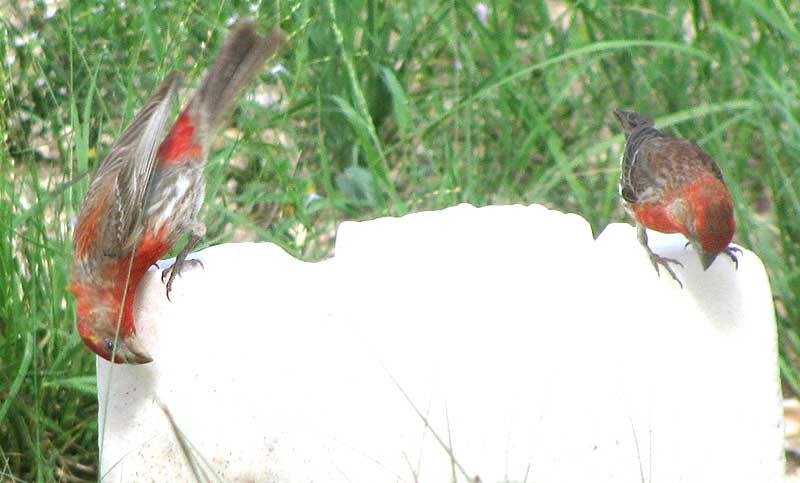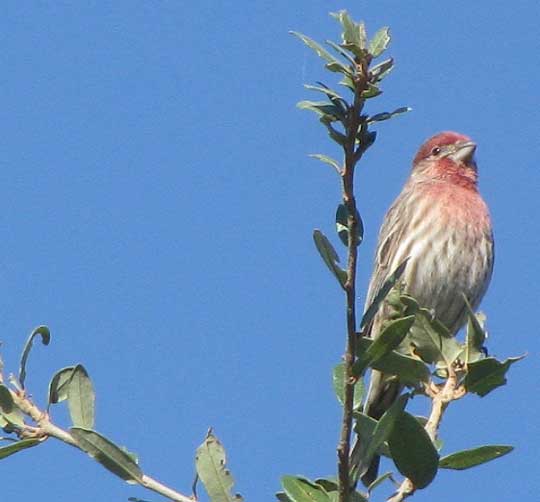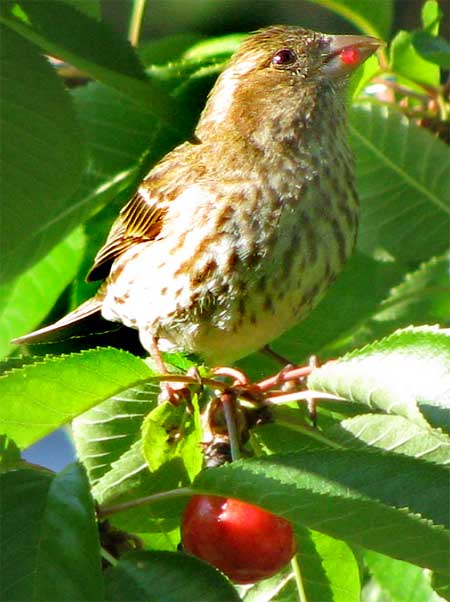Excerpts from Jim Conrad's
Naturalist Newsletter

from the June 30, 2013 Newsletter issued from the valley of the Dry Frio River in northern Uvalde County, southwestern Texas, on the southern border of the Edwards Plateau; elevation ~1750m (~5750 ft); N29.62°, W99.86°; USA
SALT-EATING FINCHES
A stone's throw from the nature center there's a salt block left from last year when deer hunters claimed the area. All through the day, just about any time I glance at the block, one or more House Finches and an occasional Mourning Dove can be seen atop the block or at its base. Sometimes it's as if the local House Finch community uses the block as a social gathering point, for among block visitors there's usually a lot of flitting about and excited calling. Other times the birds just work at acquiring salt from the hard, smooth block. You can see both techniques above.
Often the birds just peck at the salt, as the one on the right is doing. However, notice how the bird on the left holds his forward-sliding head so that the side of his beak scrapes over the block's surface. Sometimes they'll tilt their bodies forward and slide their beak bottoms along the block's top. Are their tongues hanging out, licking the salt? It happens so fast I can't see and it doesn't show in my pictures.
I worried a little that the salt might harm the birds, so on the Internet I sought information on the matter. There's not much to be found, except that Sally Roth's 2012 book Attracting Songbirds to Your Backyard, which is partly accessible via Google Books, writes that "Goldfinches, house finches, purple finches, grosbeaks, native sparrows, doves and other songbirds flock to salt blocks to peck at the mineral."
It seems that thick-billed finches as a group are especially attracted to salt. With regard to whether the salt might be bad for them, Roth says that "No studies have been done on whether salt harms them. Birds generally know what they can and cannot eat."
from the November 4, 2012 Newsletter issued from the valley of the Dry Frio River in northern Uvalde County, southwestern Texas, on the southern border of the Edwards Plateau; elevation ~1750m (~5750 ft); N29.62°, W99.86°; USA
HOUSE FINCHES' CHEERFUL CALL
Being between breeding seasons, birds here are generally quiet these days, maybe the most noticeable calls being the hoarse, lusty croaks of the occasional Raven flying over the valley. However, on certain mornings when sunlight warms things up so agreeably, sometimes you hear a cheerful-sounding but soft and tentative, rambling sort of birdcall, perfectly harmonious with the morning's generous and benevolent sunlight. If you track down the calling, it's likely to be issuing from a bird and a place like that shown below:

That's a male House Finch at the very top of a Texas Live Oak with his chest fully against the sunlight. It's almost as if the warming sunlight were squeezing his warbling from him. Here's one description of the House Finch's song:
"To human ears, the keynote of all house finch utterances is cheerfulness. The song suggests happiness, and even the notes that express anxiety over peril to the nest have a cheerfully rising inflection. Entirely absent from their vocabulary are the strident bickering cries and harsh scolding notes that are so freely used by many other species."
Nowadays it's forbidden to speak of animals other than humans in terms such as cheerfulness and happiness, for it is anthropomorphic. However, I blame the manner in which our society is so hard on other living things largely on our lack of empathy with other living things, and sometimes a little anthropomorphism is needed to catalyze empathy. So, I indulge in it sparingly, and am glad to say that a House Finch's little warbling on a sunny morning is cheerful.
By the way, that quotation above, about the House Finch's utterances suggesting happiness, is from the Bent Life History Series of monographs published by the Smithsonian Institution between the 1920s and 1950s. As a kid on the farm in Kentucky, that's where I learned most of my bird facts, eventually owning a whole library shelf filled with nothing but editions of that series. Now the series has been incorporated into the Birdzilla.com website and I derive much pleasure by going back and reading how naturalists of earlier times were not only sharp-eyed, as they are now, but also unrepentantly anthropomorphic. You might enjoy reading their comprehensive treatment of the House Finch at http://www.birdzilla.com/birds/House-Finch/bent_life_history.html.
Here's another example from the Bent series:
"The building of the nest is accomplished by the female with little or no practical assistance from her mate, who, however, follows solicitously and lightens her labors with song."
from the June 21, 2009 Newsletter, issued from the Siskiyou Mountains west of Grants Pass, Oregon:
CHERRY LOVING HOUSE FINCH
The cherries are running out fast so I've been taking advantage of them while they're available, snapping bird pictures. Below is a female House Finch, CARPODACUS MEXICANUS, with a very satisfied look on her face:

from the February 15, 2004 Newsletter, issued from the woods near Natchez, Mississippi, USA:
THOSE RASPBERY-COLORED FINCHES AT BIRD FEEDERS
When I was a kid in Kentucky learning my birds, my Peterson fieldguide taught me that in the US there were two look-alike, raspberry-colored species of finch likely to appear at bird feeders. One was our Purple Finch and the other was the House Finch, CARPODACUS MEXICANUS. Though these two species looked a lot alike, in Kentucky there was no problem distinguishing them because the House Finch was a native of western North America, so it simply didn't occur there.
Back in the 70s when I lived in Nashville, Tennessee, one day a birding friend called excitedly reporting that a House Finch from out West had turned up at a feeder on the south side of town. That day a hoard of Nashville birders descended on that feeder, hoping to add the House Finch to their Life Lists.
Sometime in the 80s while visiting my mother in Kentucky, one morning while jogging down a street I noticed a long line of finches perched along a power line. I assumed that they were Purple Finches, despite their seeming louder, shriller, and somehow more assertive than I'd remembered Purple Finches to be. When I got back to the house I found the feeder swarming with these birds, which turned out to be, of course, House Finches, not Purple Finches.
Today, throughout most of eastern North America, if a raspberry-colored finch turns up at a feeder, probably, but not always, it's a House Finch. In places, House Finches are absolutely abundant.
The speed with which House Finches have occupied eastern North America is mind-boggling. The distribution map in my old fieldguide still shows House Finches as completely absent from eastern North America, except for a small area around southern New York where a few birds had begun showing up by the fieldguide's copyright date of 1966.
At this point you might want to go to the USGS pages for these two birds and compare their CURRENT summer distribution maps (BBS map) and winter maps (CBC), at:
House: www.mbr-pwrc.usgs.gov/id/framlst/i5190id.html
Purple: www.mbr-pwrc.usgs.gov/id/framlst/i5170id.html
Just look at where House Finches are found today! They are common to abundant throughout eastern North America, with very high concentrations in the Northeast. Also, notice how our "native" Purple Finches are highly migratory, being mainly Canadian during the summer and found in most of the US only during the winter. Compare this with the House Finches' modest seasonal shifts in distribution. House Finches don't undergo dramatic seasonal migrations because seeds at birdfeeders are available year round.
from the June 1, 2006 Newsletter, issued from Polly's Bend, Garrard County, in Kentucky's Bluegrass Region:
HOUSE FINCHES & PAPER MULBERRY FIBER
Behind the old farmhouse I'm in there's a fencerow overgrown with Paper Mulberry, BROUSSONETIA PAPYRIFERA, an invasive tree from Asia.
Ruth suggested that I clear the trees away because they stand between me and a fine view across rolling hills to the cliffs along the Kentucky River to our west. I can't stand that idea, though, because all kinds of critters use that habitat. There's too much to SEE in that hedgerow to cut it down just so you can see...
Nowadays one species using the mulberries a lot is the House Finch, many of whom are building their season's second nest. Each morning I see them inside the mulberry thicket tugging at something. The binoculars show that they're pulling fibers from mulberry stems. The fibers look just like the sisal or henequen fibers we had in the Yucatan. You can walk out to the trees, with your thumbnail dig into a young stem, and pull out such fibers yourself. They're strong, as are the fibers of our native mulberry species.